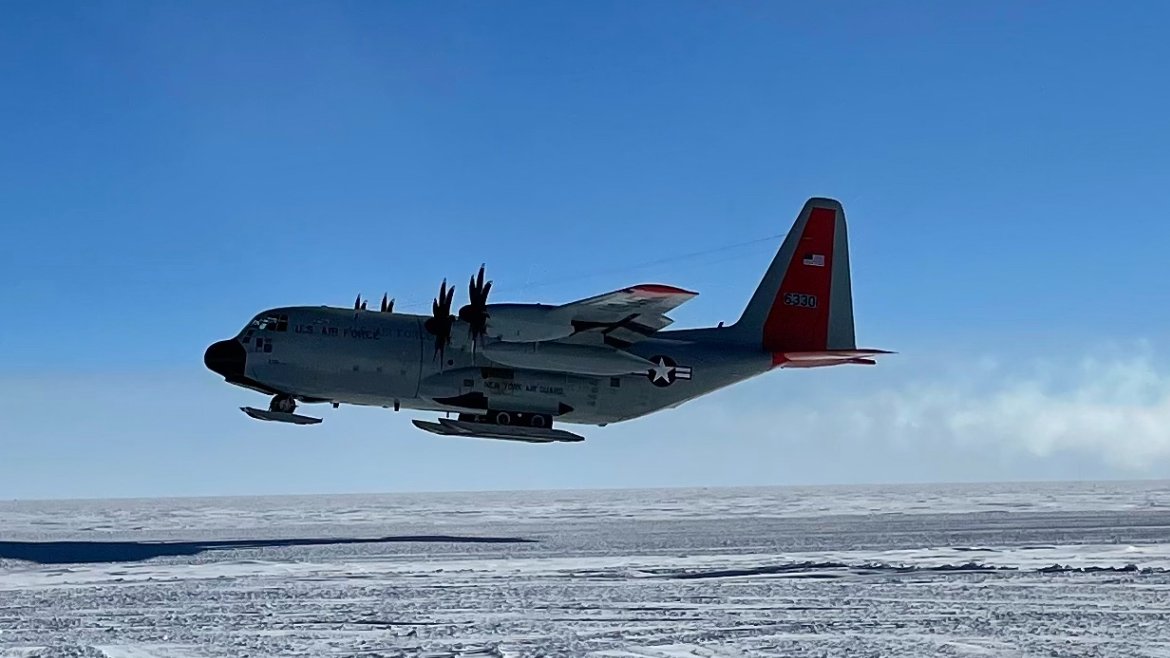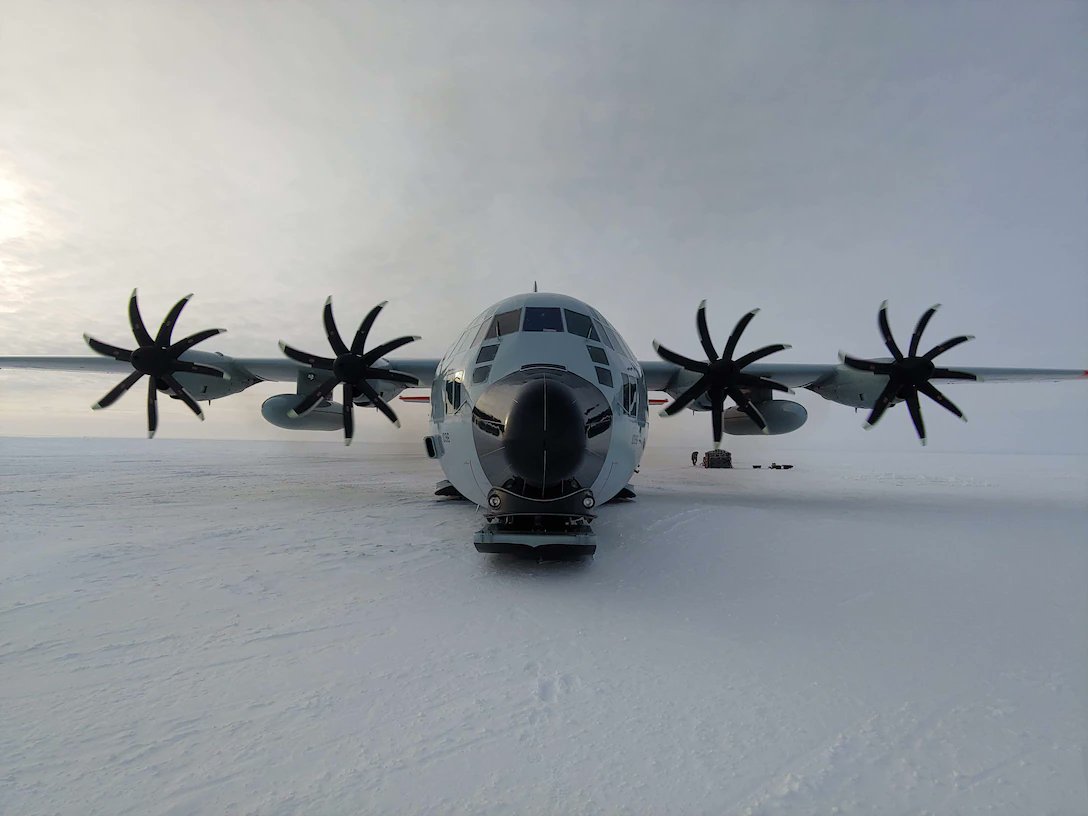


Commendable effort it was ! A maintenance team made up of Guard Airmen from three states, spent November 23rd through the 25th at the bottom of the world , braving dangerous sub-zero temperatures, to repair an LC-130 “Skibird” stranded at Amundson-Scott South Pole Station.
The plane was stranded at the South Pole following a routine supply mission when a cable controlling the elevator on the tail broke.
Staff Sgt. Jonathan Hooker, a crew chief from 109th Airlift Wing, Staff Sgt. Grant Santese, an aerorepair craftsman from Pennsylvania’s 193rd Special Operations Wing, and Tech Sgt. Dennis Craig, a hydraulics craftsman from Kentucky’s 123rd Airlift Wing were flown in to make the fix.
The plane, equipped with skies to land on snow and ice, is one of five being flown by the New York Air National Guard’s 109th Airlift Wing to resupply American science research stations across Antarctica.

Aircraft equipped with skies to land on snow and ice.
The airlift support is a component of Operation Deep Freeze, the Department of Defense support for the National Science Foundation’s Antarctic research.
Getting the aircraft working again was vital for the mission, said Major Jim Roth, the commander of the 109th Maintenance Squadron.
Known as “skibirds”, the LC-130s make regular 850 miles flights from McMurdo Station on the Antarctic coast to the South Pole Station to bring in supplies and scientists. They also fly to other science stations.
“We deploy with a finite number of aircraft our members know the importance of returning these planes to fully mission capable status as soon as possible,” Roth said.
“This is a prime example of our deployed members understanding the importance of the mission in Antarctica,” he said.
“In addition to executing the Air Force’s Arctic Strategy on a daily basis, they are also helping to provide critical support to an entire continent,” Roth added.
The LC-130s are the largest ski-equipped aircraft in the world. The key components of the South Pole Station were flown to the location by the 109th Airlift Wing.
A LC-130 "Skibird" from the @109thAW lands on Alaska's icy terrain in support of Exercise Arctic Eagle.
Once the maintenance team was on the ground, the Airmen immediately began troubleshooting the issue on the aircraft, parked on the exposed ice and snow runway.
There are no hangers or shelters at the South Pole. The planes land, unload cargo on the open skiway – the term for a snow runway--and take off again.
The temperature was -40 degrees Fahrenheit, with windchill bringing it down to about -55 degrees, said Craig, who was also the recovery team leader for the mission.
The team worked into the early morning hours on the open ski runway to isolate the issue and figure out the repair that had to be made, Craig recalled.
“It was a struggle to maintain warmth and we began to have symptoms of frostnip from the extreme cold and cyanosis from the 9,600 foot elevation we were working at,” Craig said.
Cyanosis is a lack of oxygen in the blood, caused by extremely cold temperatures which can lead to respiratory failure or heart failure.
Temperatures feel to -77 Fahrenheit on the second day, But the crew was able to continue fixing the elevator issue, and also fixed an engine low oil issue, all while exposed to the elements, Craig said.
The South Pole station complex is an 70,000 square foot building with a game room, gym, dining hall, TV room, and space for 150 people. COVID-19 precautions currently require people entering the station to isolate ahead of time to prevent the spread of the virus.
For this reason, the three Airmen maintainers had to spend the night in a small isolation hut adjacent to the station.

Chief Master Sgt. Ron Jemmott, the superintendent of aircraft maintenance at McMurdo Station, said the mission illustrates the challenges of working in Antarctica.
“This aircraft rescue was a reminder of the daunting tasks that are down here, working in austere environments,” Jemmott, said. “It takes a toll on your body but they keep a positive attitude and get the job done”.
The aircraft was ready to return to McMurdo Station two days later, a new aircrew was flown in and both planes made a safe return.
“This successful recovery showed that the maintenance recovery team and augmentee program embody the true spirit of Operation Deep Freeze, teamwork, unit cohesion and a drive for mission success,” Craig said.
This was Craig’s first year working as an augmentee alongside Airmen from the 109th Airlift Wing. Airmen from other Guard units routinely serve as part of the 109th’s mission.
“It has been a blast working with the 109th, “It has been extra cold this year on the ice, but the 109th has a way of bringing everyone together and encouraging individuals to overcome adversity and hardships and get the mission done,” Craig said.

LC-130 assigned to the New York Air National Guard’s 109th Airlift Wing sits on the ski-landing area on the sea ice near Deadhorse, Alaska in March 2021.
There are a lot of new Airmen on the maintenance mission, Jemmott said. But they are learning quickly, he added.
“It gives me a lot of hope for the future knowing that with some guidance and mentorship this mission is going to be left in good hands,” he said.
"The individuals coming up are going to be able to take the mission from where their predecessors have left and move forward with it and write their own stories,” Jemmott said.
Source : A Report By Jaclyn Lyons / 109th Air Wing/Public affairs.
